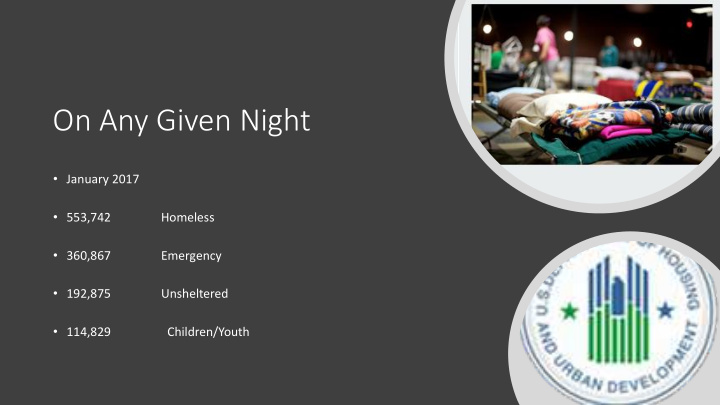



On Any Given Night • January 2017 • 553,742 Homeless • 360,867 Emergency • 192,875 Unsheltered • 114,829 Children/Youth
Hidden and Forgotten Populations During Disasters • Considering Individual and Families who are Homeless
Overview • What do we mean by “Homeless”? • The homeless and people with disabilities-The Connection. • Disasters and the homeless • Recovery challenges and solutions • Resources
What do we mean by Homeless? • An individual or family who lacks a fixed, regular, and adequate nighttime residence, meaning: • An individual or family with a primary nighttime residence that is a public or private place not designed for or ordinarily used as a regular sleeping accommodation for human beings, including a car, park, abandoned building, bus or train station, airport of camping ground. • When we talk about an individual or family, this includes unaccompanied youth 18-24. • This is often also referred to as unsheltered.
Chronic Homelessness • A homeless individual with a disability, as defined by the McKinney Vento Homeless Assistance Act (similar to the ADA and the definition used in the Stafford Act); • Living in a place not meant for human habitation, a Safe Haven, or in an emergency shelter;
Women Alone on the Street
• Unsheltered Homeless Youth
Robert T. Stafford Disaster Relief and Emergency Management Act • Section 308 (42 U.S.C. 5151) • Such regulations shall include provisions for insuring that the distribution of supplies, the processing of applications, and other relief and assistance activities shall be accomplished in an equitable and impartial manner, without discrimination on the grounds of race, color, religion, nationality, sex, age, disability, English proficiency, or economic status .
Disaster Assistance- Limitations • Federal Disaster Assistance • Lack of adequate income; or no prior income (unemployed, under employed) • Pre-disaster living situation not considered a residence, i.e., tent, car, etc. • No address • No resources • Homeless due to the disaster • Prior to the disaster-lack of adequate income to find housing; • For those living in non-traditional situations (sleeping on couches, or doubled up), there may be no proof of residence
Closing a General Population Shelter • Who is typically left in the disaster shelter? • Pre-disaster homeless • Post-disaster homeless • Issues in closing shelters • Lack of resources for either group • Affordable • Accessible housing • Employment • Services • Risks • Return to homelessness • Become homeless
Planning – Pre-Disaster • Planning prior to the disaster with community resources • Identify Resources • Continuums of Care (CoCs) • Local homeless programs and providers • Homeless boards and advocacy groups • Affordable housing coalitions • Existing state and local programs • Incorporate into plans policies and procedures • Housing the homeless in disaster shelters – non- discrimination • Transition from shelters-how to transition those who are not eligible for disaster assistance
Unaccompanied Homeless Youth
Shelter Transition Planning Benefits • Ensure those who are homeless or became homeless do not go back to the streets; • For the Chronically Homeless; providing options for affordable, accessible housing in the community; • Use of existing services and programs-reduction in duplication of services and benefits; • Reduce the time shelter remain open for those who are hard to place; • Provides long-term solutions, rather than short-term or temporary ones. • Expertise in working with Veterans, domestic violence survivors, and youth
Unaccompanied Homeless Children
Shelter Transition Model • HUD, ARC, FEMA, Homeless Representatives • 4 Phases Housing Transition Model • Phase 1-the event happens • Phase 2-Shelter population begins to decline • Phase 3-Population plateaus • Phase 4-Shelter closes
QUESTIONS? • Contact Information • Linda L. Landers, MPA • 202-204-5046 • Linda.L.Landers@HUD.GOV • Department of Housing and Urban Development • Community Planning and Development • Special Needs Assistance Program • Washington, DC
Recommend
More recommend